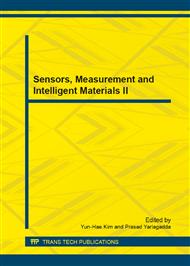[1]
Lintermann B, Deussen O. Interactive modeling of plants. IEEE Computer Graphics and Applications, 1999, vol. 19(1): 56~65.
DOI: 10.1109/38.736469
Google Scholar
[2]
Shlyakhter I, Rozenoer M, Dorsey J, et al. Reconstructing 3D Tree Models from Instrumented Photographs. IEEE Computer Graphics and Applications, 2001, vol. 21(3): 53~61.
DOI: 10.1109/38.920627
Google Scholar
[3]
Pfeifer N, Gorte B, Winterhalder D. Automatic reconstruction of single trees from terrestrial laser scanner data. Proceedings of XXth ISPRS Congress , 2004, 114~119.
Google Scholar
[4]
Pfeifer N, Winterhalder D. Modelling of tree cross sections from terrestrial laser scanning data with free-form curves. International Archives of Photogrammetry, Remote Sensing and Spatial Information Sciences, 2004, vol. 36(8): 587~593.
Google Scholar
[5]
Binney J, Sukhatme GS. 3D Tree Reconstruction from Laser Range Data. IEEE International Conference on Robotics and Automation, 2009, 1321~1326.
DOI: 10.1109/robot.2009.5152684
Google Scholar
[6]
Brodsky D, Watson B. Model simplification through refinement. Proceedings of graphics interface, 2000, 221~228.
Google Scholar
[7]
Shi BQ, Liang J, Liu Q. Adaptive simplification of point cloud using k-means clustering. Computer-Aided Design, 2011, vol. 43(8): 910~922.
DOI: 10.1016/j.cad.2011.04.001
Google Scholar
[8]
Laefer DF, Truong HL, Fitzgerald M. Processing of terrestrial laser scanning point cloud data for computational modelling of building facades. Recent Patents on Computer Science, 2011, vol. 4(1): 1~14.
DOI: 10.2174/1874479611104010016
Google Scholar
[9]
Cole-Mclaughlin K, Edelsbrunner H, Harer J, et al. Loops in Reeb Graphs of 2-Manifolds. Proceedings of 9th annual symposium on Computational geometry, 2003, 344~350.
DOI: 10.1145/777792.777844
Google Scholar
[10]
Gorte B, Pfeifer N. Structuring laser-scanned trees using 3D mathematical morphology. XXth Congress of International Archives of Photogrammetry, 2004, 929~937.
Google Scholar
[11]
Bucksch A, Lindenbergh R. CAMPINO: A skeletonization method for point cloud processing. ISPRS Journal of Photogrammetry and Remote Sensing, 2008, vol. 63(1): 115-127.
DOI: 10.1016/j.isprsjprs.2007.10.004
Google Scholar


